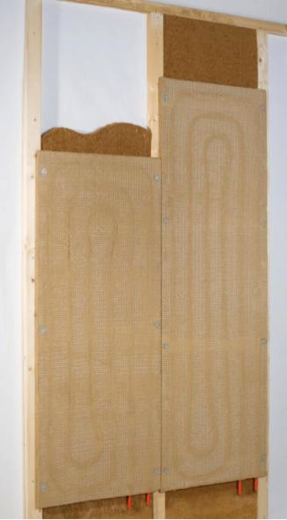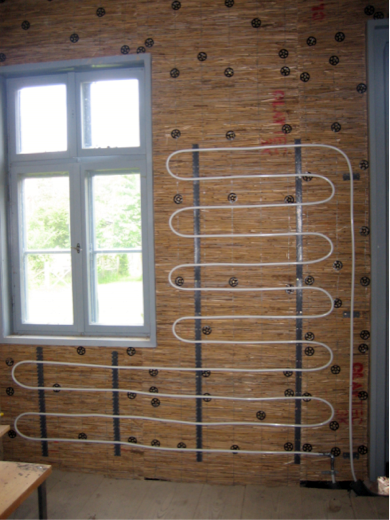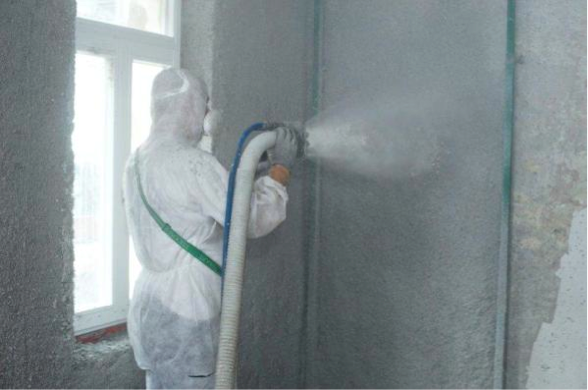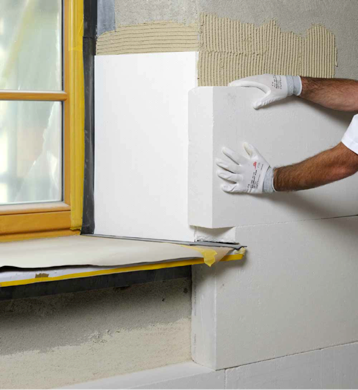01 02 03 04 05 06 07
07_Internal insulation
Internal insulation
Internal insulation is advisable if thermal insulation cannot be applied to the outside of a wall during building renovation, for example in the case of listed buildings. However, external insulation of walls is preferable in terms of the physics of buildings; this is because thermal bridging can be minimized more easily and more energy-efficient structures can be produced with external insulation.
Two short videos show internal insulation in practice:
https://www.youtube.com/watch?v=oH-M9jFjK5E
https://www.youtube.com/watch?v=7O3gCsNCfSY
EXAMPLE BOX
Internal insulation can also be combined with wall heating systems, as shown in the following figures. The figures further below show internal insulation with sprayed cellulose and with aerogel insulation, respectively.

Dry construction wall heating element made of clay on a supporting structure with softwood fibre insulation panel (source: WEM Wandheizung GmbH)

Wall heating pipes on an internal insulation made of bast fibre (source: Oesker 2007; http://de.wikipedia.org/w/index.php?title=Datei:Wallheating_pipes_on_bast_fiber_ insulation.jpg&filetimestamp=20071223213245)

Internal insulation system applied by spraying on cellulose; particularly useful for very uneven surfaces (source: Isocell GmbH)

Applying highly efficient aerogel internal insulation with a thermal conductivity λ of 0.16 W/mK (source: Schulze Darup)
Planning must take into account that, in the context of the physics of buildings, residential buildings must always meet the users' needs, while providing a good indoor climate and hygienic indoor air quality.
Planning internal insulation requires a detailed analysis of the situation in question. If implementation is faulty, damage due to the physics of buildings is more likely than if the insulation system is on the outside of the thermal envelope.
The main disadvantages of internal insulation are connected with the difficult situation in terms of the physics of buildings. Reliable solutions must be achieved that rule out moisture problems resulting in mould developing. In addition care must be taken that the moisture content of wood does not increase, particularly in structures with timber components.
The attainable U values are usually less good than with external insulation systems. The energy-saving potential is further limited by thermal bridging that usually occurs at intersecting construction elements. A preliminary slight cost advantage can turn into its opposite if expensive work needs to be done on the connections of intersecting construction elements (walls and especially timber beam ceilings). This is particularly true if structures have to be opened up and details have to be implemented at relatively great expense, for example in intersecting timber beam ceilings.
Another point: living space is diminished if the insulation is applied on the inside. The usable or rentable space shrinks, impairing economic efficiency further.
Special attention should be paid to the fact that in internal insulation, load-bearing ceilings and intersecting interior walls penetrate the insulation layer of the external wall. These spots involve high thermal bridge loss coefficients, which not only compromise the energy balance sheet, but can also cause problematic cold areas on the inner surface where moisture can condense. This is why it is urgently recommended to assess individual thermal bridges in such structures. Thermal bridging caused by intersecting elements can be reduced if an insulation wedge or an insulation panel 30 cm deep is installed in the area of intersection. This lengthens the path of heat flow, and thermal bridging is reduced.
Licensed under the Creative Commons Attribution Non-commercial No Derivatives License 4.0